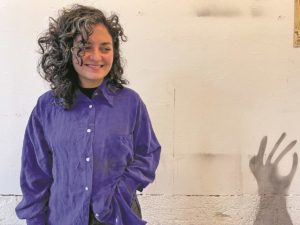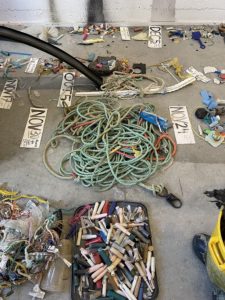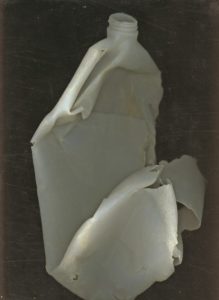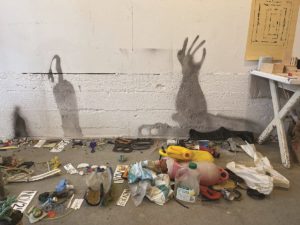The title of S. Emsaki’s show at the Fine Arts Work Center’s Hudson D. Walker Gallery, “Some Things Last a Long Time,” refers to the plastics that she collects and sorts from Cape beaches. Emsaki created a similar installation for the recent FAWC fellows exhibition at the Provincetown Art Association and Museum, which she paired with two ink drawings that catalogued the trash in a different way.

Her studio is full of piles of nylon rope, beach toys, fishing nets, buoys, tampon applicators, and drink containers. “I date them and put the location where I find them,” says Emsaki.
Born and raised in Isfahan in central Iran, Emsaki immigrated to the U.S. with her family in 2010 when she was 20. She holds a B.A. in visual arts from the University of California, Berkeley and an M.F.A. from Yale.
“It’s kind of like gleaning,” Emsaki says of gathering materials from the beach. “It’s like when you go clamming. It’s a ritual. It’s diaristic. That’s why I date them. It has to do with what I can carry on the walk.” The search and collecting are as much a part of the work for her as creating the installation itself.

Emsaki acknowledges her motivation isn’t wholly environmental. “These things are not necessarily activism for me,” she says. “There is an absurdity in trying to clean up after such a large contamination. There’s no end to it.
“It’s very important for me to question the origins and politics of the materials I use — the process required before it gets to our hands,” she continues. “Sometimes we take those things for granted when the whole work becomes about the image. Since I’ve been here, I realized I could do a much slower meditation on the materials, substrates, everything I make work with.”
Another force behind the work is the relationship between petroleum and plastic. She’s struck by the “constant struggle over resources, and oil in so many other forms,” she says. “It’s all around us. It’s as vital as water.”

Emsaki says viewers are sometimes challenged by her work: “There is a struggle. People come to the studio, and they’re immediately attracted to the drawings because it’s a more tangible medium for understanding art. It’s a more familiar form. I don’t really have control over how the work is interpreted, and I don’t think I want that control. I’m interested in this whole idea of what’s art and what’s not, both theoretically and very literally.”
While Emsaki’s drawings fulfill the need for something beautiful to hang on your wall, the work as a whole is “deeply political,” she says. “It is also deeply personal and about identity. But for the past few years, it’s been really important for me to make work that speaks beyond ideas of culture or language — something that is felt.”
On the wall of her studio are shadow drawings — silhouettes of indeterminate forms, applied freehand and with stencils. “I’m deeply interested in the material presence of objects,” she says. “Shadows don’t have any substance. It’s not energy, it’s not light. It’s the absence of all which is so interesting to me. There’s also the psychology of shadows. It’s a very important part of how we see. We see color, shapes, and shadows.”

The shadow drawings are made with locally sourced squid and walnut ink — the same that she uses for her trash still lifes. “They’re a way for me to sit down and think about the materials and look at their forms,” she says of the still life drawings. “So much of the thinking that I do happens on paper.
“They’re fairly quick drawings,” she continues. “They’re not trying to represent the object in its aesthetic. You observe it in a deeper way when you’re drawing it. What can happen next? What can this do?” Emsaki says she treats drawing as a “conceptual tool,” an alternative to writing. “It’s a way for me to archive things,” she says.
What the artist offers is an awareness, a conversation — not a solution: “I think of my role as being an attentive observer,” she says. By looking closely, she encourages viewers to do the same. “It’s about the immaterial that we can take with us that goes beyond a picture,” says Emsaki. “What I can hope is it’s a new way of seeing, a new way of thinking.”
Out of the Shadows
The event: A show of works by S. Emsaki
The time: By appointment; Friday, March 25 through Tuesday, March 29; reception Friday, March 25, 5 to 7 p.m.
The place: Hudson D. Walker Gallery, Fine Arts Work Center, 24 Pearl St., Provincetown
The cost: Free



